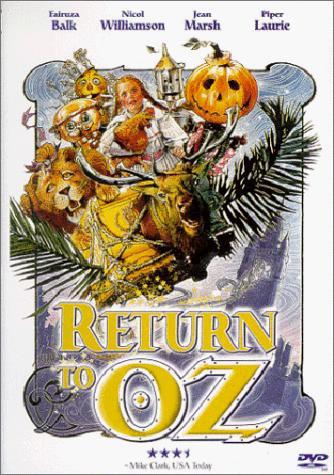One could see the latest incarnation of Oz and its inhabitants as yet another example of Hollywood’s lack of new ideas, another shameless cash grab. And it very well could be. But there’s another way to look at it: as a testament to the abundance of the magical world L. Frank Baum created over a century ago, with many stories and new directions ready to be adapted by literary, theatrical, and cinematic artists. His fantasy world full of cowardly lions, wicked witches, and emerald cities seems irresistible to each new generation, and so we’re always returning to Oz.
But as with any series or franchise, some return trips have been more delightful than others. The Wizard of Oz, of course, remains the blueprint for cinematic adaptations; at this point it seems likely that more people have seen it than read any of the original source material. And in the less delightful camp falls the decidedly darker Return to Oz, Disney’s long-forgotten sort-of “sequel” to the 1939 classic, released in 1985. I hadn’t seen or thought about this movie since I was a kid. I don’t remember loving it then—and, having given it another look, I certainly don’t love it now.
As the title suggests, Dorothy, played by a nine-year-old Fairuza Balk, returns to that magical place beyond the rainbow, only this time everything is different. For starters, Toto is left behind in Kansas and replaced as Dorothy’s sidekick by a talking chicken named Billina. The Emerald City is no longer emerald, and nearly everyone, including the Cowardly Lion and the Tin Man, has been turned to stone (or in the Scarecrow’s case, an ornament) by the Nome King (a shape-shifting rock) and his accomplice, Mombi (a witch who has a hallway full of women’s heads in display cases, which she wears interchangeably, as if they were hats). In lieu of her three previous companions, Dorothy is now aided by Tik-Tok, a robot that is supposed to protect Dorothy but needs constant winding to be helpful; Jack Pumpkinhead, whose lanky body made of sticks is reminiscent of the Scarecrow (and could have inspired Tim Burton’s Jack Skellington); and the Gump, a talking moose-head wall ornament.
Suffice it to say, the movie is quite weird. Which is not a problem, of course, since this is Oz and that’s to be expected. The script was developed from two of Baum’s (many, many) sequels, The Marvelous Land of Oz and Ozma of Oz; the film probably owes more of a debt to those books than it does to the 1939 film. But Return to Oz still tries to recapture some of the earlier movie’s magic—the ruby red slippers are prominently featured—and never gets out from under the original’s shadow. (The slippers in the Baum books were silver; Disney licensed the rights to the ruby ones, which highlights how powerful that film’s legacy still is.)
More successful adaptations have taken a very deliberate step away from the 1939 movie. The Broadway production of The Wiz adopted a black perspective, and the book and musical Wicked cleverly told the tale from the witches’ points of view. The closest thing to a comparable move by Return to Oz was its decision to go grim: In the first 25 minutes or so, Aunt Em and Uncle Henry, worried about Dorothy’s insomnia and crazy talk of lions and tin men six months after the tornado, decide the best thing for her would be “electric healing”—or electroshock therapy. Thanks to a power outage during a storm and the help of a mysterious girl at the hospital, Dorothy manages to escape from the evil doctors, but gets caught in inclement weather yet again. This prompts her “return to Oz.”
It’s not hard to understand why this version tends to be struck from popular memory—like most of Disney’s 1980s output, the company has mostly pretended it never happened, save for occasional airings on its cable channel in the early ’90s, which is where I first encountered it. The 1939 classic has made us want to return to its strange land again and again, but it has also made successful subsequent journeys nearly impossible. The cast and director of Oz the Great and Powerful make that movie, opening tomorrow, look more promising—but I won’t be surprised if we’ve all decided to forget it a few years from now.
